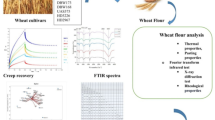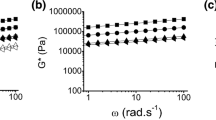Abstract
The effect of steaming on the various rheological characteristics of wheat flour dough was studied. Steaming of flours at atmospheric pressure for 15 min completely denatured the gluten and reduced the water absorption capacity from 58.4% to 45.0%. Even steaming for just 5 min increased the resistance to extension considerably from 500 BU (Brabender Units) to 1000 BU and the ratio figure (resistance to extension/extensibility) from 4.2 to 27.4, indicating stiffening of the dough. The dough made from steamed flour had a higher hardness value of 91.1 N than the dough made from raw wheat flour which had a value of 51.1 N. The pasting characteristics of flour steamed for 15 min measured in a Rapid Visco Analyser showed increased peak viscosity from 218 rapid visco units (RVU) to 257 RVU as well as increased cold paste viscosity from 175 RVU to 200 RVU and increased hot paste viscosity from 94 RVU to 108 RVU for flour steamed for 15 min.
Similar content being viewed by others
Author information
Authors and Affiliations
Additional information
Received: 4 August 1998 / Revised version: 23 October 1998
Rights and permissions
About this article
Cite this article
Prakash, M., Haridas Rao, P. Effect of steaming on the rheological characteristics of wheat flour dough. Eur Food Res Technol 209, 122–125 (1999). https://doi.org/10.1007/s002170050469
Issue Date:
DOI: https://doi.org/10.1007/s002170050469




